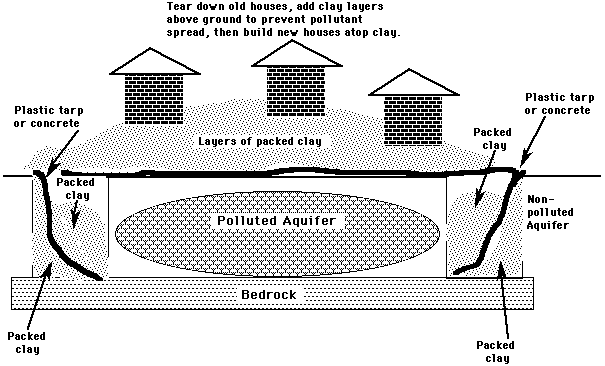Containment
Containment is a way commonly used at toxic waste storage sites
and also at many municipal waste sites to prevent the further spread of toxic
chemicals. Essentially, a barrier is put under or around an area where poisonous
materials are found. At municipal waste sites (what we would call a dump),
a hole is dug in the ground. Often clay, which allows very little water movement
through it, is laid down in the hole, and then compacted to make the holes
between the clay particles even smaller. Typically, several layers of thick
ply plastic tarp are laid down on top of this clay layer, and then another
layer of clay is placed atop the plastic tarp to protect it from machinery.
In an area where the aquifer is polluted, the best way to prevent
spread of the toxic liquid is to first dig a ditch around the perimeter of
the spill, digging down to bedrock (aquitard). It's vital that the bedrock
layer isn't too deep, or this isn't economically feasable. After the ditch
is laid, various materials are deposited in the ditch which will hopefully
retard the movement of pollution out of the area. Such materials are concrete
(only useful in small areas), thick plastic tarps, or compacted clay.
In addition, a thick layer of clay, and perhaps plastic tarps
are placed over the surface of the ground, so that the poison can't move out
of the ground into surface waters or into the air.

Cost: about $11 million/ or about $210
extra per year on the tax bill over a period of 10 years.
Pros
1. Relatively inexpensive.
2. Buildings may not need to be dug up and removed if the toxic
chemicals are deep underground.
2. Prevents spread of the pollution.
3. This method is quick.
4. This method has been used effectively at municipal waste
areas.
5. Little danger to public during the digging and placing of
containing materials.
Cons
1. Must monitor water for years. Some of the toxic chemicals
may leak!
2. Worker safety during installation may be an issue (if the
ditch is deep---possible cave ins).
3. If the clay is not compacted correctly, or a rip in plastic
tarps develops, the toxic chemical may leak.
4. The pollution hasn't been moved. If public records are lost
over the years, people may build over the polluted site and later become poisoned
(Research "Love Canal").
Links:
Love
Canal Collection: A town in New York state built on a "contained"
toxic waste site.
[GHS Biology
Pollution Cleanup Options Menu]
Paul Slichter